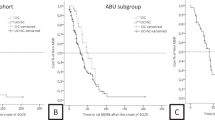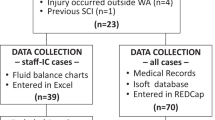Abstract
Study design: Prospective analysis.
Objectives: To investigate the colonization of the distal urethra and bladder during the initial stages of rehabilitation in acute spinal-cord injury (SCI) and to examine the association between bacteriuria and colonization of the distal urethra.
Setting: Selcuk University Meram Faculty of Medicine, Konya, Turkey.
Methods: A total of 27 patients with SCI (13 females and 14 males) and 40 controls without evidence of disease of the urinary tract were studied. Cultures were taken from the patients who applied clean intermittent catheterization and compared with normal subjects.
Results: Escherichia coli was predominantly isolated from the urine and urethral cultures of both female and male SCI patients. Colonization of other bacteria in the urine and urethral cultures was similar in both female and male patients, except for Pseudomonas, which was colonized in male patients. In all, 72% of patients who had E. coli positive urethral cultures also had E. coli colonization in their simultaneous urine cultures. There was concordance between urethra and urine cultures concerning the growth of E. coli (P=0.82). When urethral cultures collected 1 week before were evaluated in patients with E. coli positive urine cultures (n=24 cultures), 15 of these urethral cultures also had E. coli colonization. There was concordance between urethra and urine cultures concerning the growth of E. coli (P=0.66).
Conclusions: Our study suggested that urethral flora was a significant source for the development of urinary infection in spinal cord-injured patients.
Similar content being viewed by others
Introduction
Spinal cord-injured (SCI) patients with neurogenic bladder dysfunction often suffer from symptomatic urinary tract infection (UTI).1 The majority of these patients have neuropathic bladder dysfunction. Intermittent catheterization (IC) technique has proved invaluable for neuropathic bladder management and gained acceptance as the preferred method since the early 1960s.2 The risk of UTI is reduced by the absence of a chronic indwelling catheter and the periodic elimination of residual urine. Despite the advantages of IC, urinary colonization and infections continue to occur in many individuals.3,4
In these patients, bacteria may be introduced into the urinary tract during each catheterization. The source of the bacteria causing the infections during the IC is assumed to be the flora in the periurethral area.
We investigated the colonization of the distal urethra and bladder during the initial stages of rehabilitation in acute SCI and also examined the association between bacteriuria and colonization of the distal urethra.
Methods
There were 27 patients with SCI (13 females and 14 males) and 40 hospital personnel without evidence of disease of the urinary tract. All of the patients had neuropathic bladder due to traumatic SCI, and were on IC. The approval of the ethics committee has been obtained for our study. The patients were informed before being enrolled in the study and written consents were obtained. Cultures were taken from the patients who applied clean IC once a week for 3 weeks. Urine and the urethral cultures were obtained at the same time to determine the relation between urinary and urethral flora. During this period, urine analysis, sedimentation, CRP and white blood-cell examination were also evaluated.
The clinical infection criteria that we utilized were as follows: A fever of >38°C, having a urinary bacterial count of 105 CFU/ml and above, the presence of urethral discharge together with one or more of the clinical signs of abdominal pain, reflex sweating, increased spasticity and frequent urinary incontinence results in the diagnosis of urinary infection.5
Asymptomatic bacteriuria is the presence of ≥104 CFU/ml bacteria without having any symptoms or fever.
If the patients were identified to have any signs of urinary infection, they were immediately excluded from the study. After identifying the appropriate antibiotic with antibiograms they were treated for a period of 10 days. Urine samples were recollected on day 10 and the antibiotics were stopped if the cultures were sterile. The patient then started using CIC again. At 1 week after the reinitiation of clean IC, the patient was reintroduced into the study. During the study period, five urinary infections were identified and treated.
In all, 162 cultures (81 urethral and 81 urine) were obtained from 13 female and 14 male patients with SCI. Cultures of urethral meatus and urine in patients with SCI were taken three times at weekly intervals for 3 weeks. We compared 81 urethral and 81 urine cultures for the simultaneous colonization between urethra and urine. Determining whether the bacteria in urine had prior urethral colonization, we compared urine cultures of the second and third weeks with urethral cultures of the first and second weeks. In this comparison, 54 urethral and 54 urine cultures were used. Urine cultures were obtained by sterile catheterization using povidone-iodine application to the external genitalia. Samples of urethral meatus were taken with sterile cotton swabs, moistened with sterile saline. The swabs were inserted approximately 1 cm into the urethra. A single urethral culture was obtained from the control group of 20 normal women and 20 men. The control group found in the study consisted of the hospital staff taking care of the SCI patients. They were normal healthy subjects. The results of the urethral cultures of patients were compared with normal subjects.
Gram-positive bacterial isolates were identified based on their biochemical profile with the classical method. Susceptibility testing was performed according to National Committee for Clinical Laboratory Standards (NCCLS) guidelines by disk diffusion method. Gram-negative bacterial isolates were identified in the laboratory according to API 20E (Bio Merieux, France) procedures. Susceptibility to different antimicrobial agents was determined by the disk diffusion tests as set out by the NCCLS.
χ2 and Fisher's exact tests were applied for comparison of the differences of groups and McNemar χ2 test to assess the agreement between the dependent groups.
Results
A total of 27 patients with spinal cord injury (13 females and 14 males) were included into our study. The mean ages of the patients were 36.3±10.9 and 38.5±15.9 for females and males, respectively. Two of the patients were tetraplegic, while 25 of them were paraplegic. Four of the patients had incomplete and 23 had complete injuries.
Each of the urine cultures contained at least 104 bacteria/ml.
E. coli was predominantly isolated from the urine and urethral specimens of both female and male SCI patients (Tables 1 and 2).
In the urine cultures, E. coli colonization was significantly higher in the female patients when compared to male patients with SCI (χ2=5.36, P=0.020).
E. coli colonization in the urethral cultures was significantly higher in SCI patients than the controls (χ2=12.6, P=0.000).
Also, the number of E. coli in the urethral cultures was significantly higher in female and male patients than their controls (χ2=7.06, P=0.0079 and χ2=6.68, P=0.01).
When the urethral flora was compared between male and female patients, Pseudomonas was the only organism found in greater numbers in the urethral cultures of male patients compared to those of females (χ2=10.59, P=0.001). Colonization of other bacteria in the urine and urethral cultures was similar in both female and male patients.
We made the observation that there was a concordance between the presence of a bacterial species on the urethra and presence of the same species in the urine on the same day (simultaneous growth) (Table 3). E. coli was present in 28 of the 39 urine cultures obtained on the same day (simultaneous) with the 39 urethral cultures having E. coli. Only nine of the urinary cultures obtained simultaneously with 42 urethral cultures not demonstrating growth for E. coli, had growth for E. coli. For the simultaneous colonization by E. coli, there was a concordance between the urethra and the urine (P=0.82). A total of 72% of the urine cultures obtained simultaneously with the E. coli containing urethral cultures had growth for E. coli.
We could compare the urinary samples on weeks 2 and 3 in which E. coli have been identified and the urethral cultures on weeks 1 and 2 which were obtained 1 week previously (Table 4). Here, we examined 54 urine and 54 urethral cultures. In this comparison, 24 urine cultures were identified to have E. coli and 15 of the urethral cultures that were obtained one week prior to these urine cultures had growth of E. coli as well. In nine urethral cultures, different bacteria were present. In 30 urine cultures, there was no growth for E. coli when urethral cultures obtained 1 week prior to these cultures were examined; 12 had E. coli. In the McNemar test that was performed, there was a concordance between the growth of E. coli in the urine and the growth of E. coli in urethral cultures obtained 1 week previously (P=0.66). In other words, for urethral cultures obtained 1 week prior to obtaining urine cultures 63% were identified to have E. coli.
Discussion
The results of this study demonstrate that urinary tract infection in SCI originates from organisms colonizing in the urethral flora. We found E. coli to be the most frequently colonizing bacteria in patients with SCI in both urethra and urine in both sexes.
Fowler6 reported that E. coli was responsible for 75% of urinary infections in adult women without neurogenic bladder and reported that bacteria causing the UTIs in these women was preceded by colonization of the vaginal and urethral mucosa.
In Bennett's study,7 E. coli was more frequently isolated in the urine of female patients when compared to the male patients with SCI and reported that E. coli accounted for 53% of urinary infections in female patients.
Schaffer et al8 demonstrated that E. coli was the most prevalent gram-negative organism in the urethral meatus of SCI patients in both sexes and showed that meatal colonization by potentially pathogenic bacteria was a major risk for catheter-associated bacteriuria, and suggested that extraluminal spread of bacteria within the periurethral space was the major route by which bacteria gained entry into the bladder during catheterization.
Hamamci et al9 found that E. coli was the most frequently isolated bacteria among all Gram-negative organisms from urethral and genital skin flora. She found identical colonization in female and male in urine and urethral meatus in both sexes. They concluded that genital skin and urethral flora were very important areas as a source of bacteria causing urinary infections in SCI patients. Bacteria appear to gain entry into the bladder through urethral catheters. These investigators hypothesized that the catheter usage organism may enter the bladder at the time of catheter insertion in patients applying IC.
E. coli and Enterococcus have been found to be the most frequently isolated organisms in the urethra and urine in SCI female patients10. These microorganisms isolated from urine samples were not isolated from urethra in one-third of the patients. Owing to this poor correlation, their speculation was that E. coli and Enterococcus sp were residing temporarily in the urethra by contamination and not colonizing in the urethral mucosa and that they were inoculated into the bladder with the catheter.10
The male patients have had a high incidence of infection with Klebsiella and Pseudomonas species.11 Montgomerie et al12 and Gilmore et al13 performed multiple studies looking at colonization of Pseudomonas and Klebsiella in the perineum and urethra in SCI male patients. These studies evaluated almost exclusively male patients and found considerably more urethral colonization with Pseudomonas and Klebsiella in patients wearing external catheters.
In previous studies, Klebsiella and Pseudomonas were the most frequently isolated organisms in male patients with SCI.12,13,14,15 However, in our study, E. coli was the most frequently isolated bacteria in both urine and urethral samples. In accordance with the results of other similar studies, we found that E. coli was the most frequently colonized organism in urine and urethra in female patients.7,8,10
In our study, we compared urethral colonization of E. coli in SCI patients with normal controls and found that E. coli colonization was significantly greater in SCI patients than controls in the urethral cultures. This made us think that the feces of the patients with spinal cord injuries contaminated the genital region including the periurethral area and that from there on the microorganisms reached the distal urethra and colonized it.
We found a good concordance between urethral and urinary colonization of E. coli in the simultaneously taken urine and urethral samples. Such a finding was not detected in Montgomerie et al's 10 study, but Hamamci et al9 found identical bacteria in urine and urethral samples.
In previous studies, before colonization in urine, bacteria were isolated from the urethra and vagina in patients without SCI.6 We also isolated E. coli in urethral samples taken 1 week before urinary colonization of the same bacteria. On the contrary, Montgomerie et al10 did not find such a relationship.
Our findings suggested that urethral flora was a significant source for the development of UTIs.
There is a large amount of fecal contamination of the perineum in patients who have their bowel program in bed during the initial stages of their rehabilitation in both sexes. Periurethral area is colonized with Gram-negative bacteria coming from bowel. The organism may spread from the meatus of the urethra and colonize in mucosa. It has been assumed that organisms are introduced into the bladder at the time of IC and colonize in the urine. Contamination and colonization of the perineum with Gram-negative bacteria are reduced after starting the bowel management program. Regular antiseptic procedures performed periodically may provide an effective hygienic care in reducing the incidence of catheter-associated bacteriuria. Therefore, the infection rate may have been lowered.
References
De Ruz AE, Leoni E, Cabrera R . Epidemiology and risk factors for urinary tract infection in patients with spinal cord injury. J Urol 2000; 164: 1285–1289.
Lapides J, Diokno AC, Sibler SJ, Lowe BS . Clean intermittent self catheterization in the treatment of urinary tract disease. J Urol 1972; 107: 458.
Erickson RP et al. Bacteriuria during follow-up in patients with spinal cord injury; rates of bacteriuria in various bladder emptying methods. Arch Phys Med Rehabil 1982; 63: 409–412.
Me Guire EJ, Savastano JA . Long term follow up of spinal cord injury patients managed by intermittent catheterization. J Urol 1983; 129: 775–776.
Maynard FM, Diokno AC . Urinary infection and complications during clean intermittent catheterization following spinal cord injury. J Urol 1984; 132: 943–946.
Fowler JE . Urinary tract infections in women. Urol Clin N Am 1986; 13: 673–683.
Bennett CJ, Young MN, Darrington H . Differences in urinary tract infections in male and female spinal cord injury patients on intermittent catheterization. Paraplegia 1995; 33: 69–72.
Schaeffer AJ, Chmiel J . Urethral meatal colonization in the pathogenesis of catheter-associated bacteriuria. J Urol 1983; 130: 1096–1099.
Hamamci N et al. A quantitative study of genital skin flora and urinary colonization in spinal cord injured patients. Spinal Cord 1998; 36: 617–620.
Montgomerie JZ et al. Urethral cultures in female patients with a spinal cord injury. Spinal Cord 1997; 35: 282–285.
Gilmore DS, Schick DG, Young MN, Montgomerie JZ . Effect of external urinary collection system on colonization and urinary tract infections with Pseudomonas and Klebsiella in men with spinal cord injury. J Am Parapleg Soc 1992; 15: 206–208.
Montgomerie JZ et al. Long-term colonization of spinal cord injury patients with Klebsiella pneumoniae. J Clin Microbiol 1989; 27: 1613–1616.
Gilmore DS et al. Pseudomonas aeruginosa colonization in patients with spinal cord injuries. J Clin Microbiol 1982; 16: 856–860.
Montgomerie JZ, Morrow JW . Long-term Pseudomonas colonization in spinal cord injury patients. Am J Epidemiol 1980; 112: 508–517.
Pearman JW, Bailey M, Riley LP . Bladder instillations of Trisdine compared with catheter introducer for reduction of bacteriuria during intermittent catheterisation of patients with acute spinal cord trauma. Br J Urol 1991; 67: 483–490.
Author information
Authors and Affiliations
Rights and permissions
About this article
Cite this article
Levendoglu, F., Ugurlu, H., Ozerbil, O. et al. Urethral cultures in patients with spinal cord injury. Spinal Cord 42, 106–109 (2004). https://doi.org/10.1038/sj.sc.3101554
Published:
Issue Date:
DOI: https://doi.org/10.1038/sj.sc.3101554



